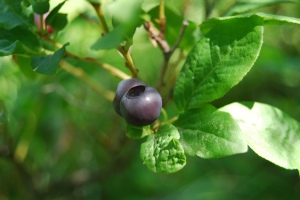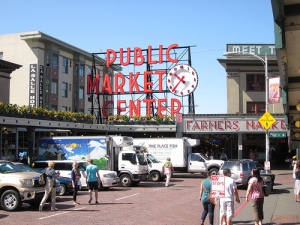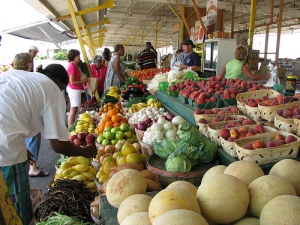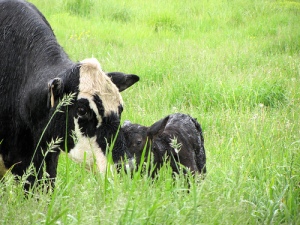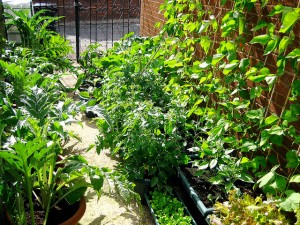
By Mary Richmond
One wet spring, the hills behind my childhood home came alive. The usually dry ground sprung leaks so that the hills seemed to be crying for joy. I discovered one of those leaks, a small hole in the ground from which sweet, icy-cold water burbled forth. I knew that this ground-level fountain was different from the puddles from which the dog lapped. This was clean water from deep within the earth. I got on all fours and took a long pull. It was the best drink I’ve ever had.
That was the first and last time I ever had the privilege of discovering a spring, and it made a lifelong impression. It worries me that so many kids are deprived of the opportunity to have experiences like that. Daily, intimate contact with nature is vital to the well-being of children, a point which Richard Louv brought home in his book, Last Child in the Woods: Saving Our Children From Nature-Deficit Disorder .
.
In the introduction to the book, Richard Louv describes a conversation he had with his son. The boy had wondered why “it was more fun” when his dad was a kid. My own boys wonder the same thing. They pine for open spaces where they would be free to play and create. Places with trees. Places like my childhood home. What science is beginning to make clear to us, my children seem to instinctively understand: kids need nature.
Nature and Health
“Those who contemplate the beauty of the earth find reserves of strength that will endure as long as life lasts.” – Rachel Carson
I used to run up the steep hills behind my house without getting winded. My daily tramps through the fields and woods had made me strong. My friends loved to come romp with me in the hills, but they often could not keep up. Lives spent parked in front of the television had made them soft.
I know that if I had lived in a suburban subdivision, there would have been little to propel me into the out-of-doors. What got me outside was not the thought that I needed some fresh air and exercise, but the prospect of all those acres to explore – “scope for the imagination”, as Anne Shirley would have said. I didn’t care a snit about the condition of my muscles or lungs, or how much my play was increasing blood-flow to my brain. All I knew is that outside felt good, and that is where I wanted to be.
Nature and Spirituality
“I go to nature to be soothed and healed, and to have my senses put in tune once more.” – John Burroughs
I could see out over the plains all the way to the distant mountains from my perch on the hill. That was where I went to be alone with God. Above it all, I was able to put my troubles in perspective and gain a sense of peace. All children should have the opportunity to find a special place, a thinking spot. They should, but they do not, which is why frequent family outings to the woods or the mountains, the lake or the river are so important.
On one such outing, I had invited a student and friend to join me and my family. On a trail in Mt. Rainier National Park, she stopped to admire the chain of jagged peaks marching off into the horizon.
“How could anybody deny that God made this?” she exclaimed in wonderment.

By Mike Baird
My own son said something similar once. When he was 5 years old, I took him on a camping trip to the Olympic Peninsula on the Strait of Juan de Fuca. We could see all the way to Canada from our side of the straight, and daily we would watch the cargo ships, sailboats, and even a submarine pass by. But what really impressed my son was not anything man-made. One day we were examining the anemones and starfish in a tide-pool.
“I just love Jehovah!” said my son.
Such is the power of nature to inspire awe and appreciation.
Nature and Intelligence
Howard Gardner is known for his theory of multiple intelligences. He originally theorized that there are 7 intelligences: linguistic, logical-mathematical, spatial, bodily-kinesthetic, musical, interpersonal, and intrapersonal. He more recently added an eighth intelligence: naturalist.
The core of naturalist intelligence is the human ability to recognize plants, animals, and other parts of the natural environment, like clouds or rocks.
– Howard Gardner
Transcendent experiences in nature intensify our senses and ability to see connections. Many of our most celebrated authors seem to owe much of their genius to their attunement to the natural world. Jane Austen, Henry David Thoreau, John Muir, Rachel Carson, and Barbara Kingsolver are a few that come immediately to mind.
Leslie Stevens views nature as an educational necessity, which is why she has moved her family to the edge of a canyon where her children might be free to roam and play. Here, she describes how nature taught her about the concept of shelter:
A child who is allowed to run free in a place that is natural will very quickly begin to look around for a special shelter. The interior framework of bushes is inspected and judged for its suitability to act as a fort. Trees, especially mature ones, provide towering castles, and the best climbing branches are claimed as “rooms”. In contrast, the exposure a child feels running across a grassy, sunny, slope or wide, open field allows her to feel the lack of shelter. It is only through experiencing both opposites that children begin to understand each part more deeply.
I learned much about shelter from my own wanderings. A big old ponderosa pine inhabiting some woods on a hill near my home provided the perfect skeleton for my playhouse. The branches of the tree curved to the ground as if it were purposely sheltering the place around its roots. I saw that with the addition of some sticks for more support, that I would be able to insulate the framework with bundles of pine-needles to create a cozy shelter. I engaged the cooperation of my brother and sisters, and we soon had a little house to please any hobbit. Many happy hours were spent there.

By Mike Petrucci
Other things I learned from my experiences in nature include the fact that snow berries are very bitter, lichens are edible but taste very bad, maple leaves are edible and taste very good, red clover is an acceptable substitute for bubble gum, certain types of flowers contain so much nectar that it can be sipped from the blossoms, moss is one of the first green things besides crocuses to appear in the Spring, and pineapple weed tastes like chamomile. I also learned that what we do makes a difference to the Earth. Because I loved to see beautiful things, I deeply resented litter and would never have thought of tossing my candy wrappers on the ground. For the same reason, I hated to see trees being cut down or streams polluted or the advancement of urban sprawl.
Important lessons I would say.
Nature and Creativity
Natural, more loosely structured environments encourage more creative play. On the playground at my school, we played tether ball. But in the hills behind my home, we played Crystal Kingdom, Lost, Train-wreck, and Indians. We created entire fictional worlds up there. It seems as if this type of play must be the stepping stone to the type of creativity that, in later years, writes great novels, paints beautiful pictures, and sculpts beautiful objects.
I could write pages about all the famously creative people who were inspired by their experiences in nature. I will, instead, let a few of them speak for themselves.
“It is not the language of painters but the language of nature which one should listen to…The feeling for the things themselves, for reality, is more important than the feeling for pictures.” – Vincent van Gogh
“I am well again, I came to life in the cool winds and crystal waters of the mountains…” – John Muir
“And this, our life, exempt from public haunt, finds tongues in trees, books in the running brooks, sermons in stones, and good in everything.” – William Shakespeare
“Come forth into the light of things, let nature be your teacher.” William Wordsworth
I wrote poetry when I was a girl. The inspiration came from trees, sun, wind, and animals. I don’t think I would have written things like the following haiku without intimate contact with those things.
Silence in the wood
A silence the wind can blow
With me there is peace
How many of our young Shakespeare’s and Van Gogh’s sit languishing in classrooms and in front of screens?
The Problem of Distraction
My kids would sit at the computer or with a tablet like punch-drunk social butterflies connected to the hive mind nearly all of the time, I believe, if I allowed it. Television and internet have drastically changed the way that we relate to the world. We are at once connected and disconnected. I once heard electronic media described as WMDs, weapons of mass distraction. That seems apt.
Henry David Thoreau had some thoughts on the social media of his time, newspapers and letters, that now seems almost prophetic:
You may depend on it that the poor fellow who walks away with the greatest number of letters, proud of his extensive correspondence, has not heard from himself this long while.
Change that to read “the greatest number of likes”, and you have a profound indictment of uncontrolled use of online social media. There is nothing inherently wrong with social media, just as there is nothing inherently wrong with newspapers or letters. But the point Thoreau was trying to make, and the one I want to make, is that those things may become a distraction from pursuits that are much more important. We should not, as Thoreau, stated, “live for idle amusement.”
In his book, Data Smog – Surviving the Information Glut, David Shenk said this:
Turn the television off. There is no quicker way to regain control of the pace of your life, the peace of your home, and the content of your thinking than to turn off the appliance that supplies, for all too many of us, the ambiance of our lives. Millions of Americans have been discovering the serenity and empowerment that comes with using the OFF switch, not to mention hours and hours of newly acquired free-time with which they can begin to do some of the things they’ve never found time for in the past.
The point is this: for kids to gain the benefits of contact with nature, we have to help them unplug. It’s amazing what happens when all the screens go dark. The skateboards come out. The dirt pile outside begins to look more attractive. Young eyes begin to rest upon birds and rabbits and clouds rather than those flickering pixels. A child begins to “hear from himself”, and I might add, from God himself as well, as God reveals himself in his creation.
The Problem of Access
I always get stir-crazy in the winter. I miss green so much that I begin looking for ways to get somewhere, anywhere, that will soothe me. One winter, after having researched Washington State Department of Fish and Wildlife river access points, I went looking for somewhere to walk where I could see water. Every access point I checked was closed to the public. The only way to approach the river anywhere near my home would have been to break the law.
I finally found a hill that overlooked the river that was not farmed (quite rare in my part of the world). I parked my car and took a walk with my dog. I enjoyed my solitude while Elsie bounded around in the brush, sniffing here and there, long tongue hanging out the side of her mouth. She flushed a covey of quail out of the sage as we approached the crest of the hill where we could see the sparkling coils of the river below, gray, leafless trees flanking its sides. I stood for a long while and let the scene penetrate and calm my beauty-hungry heart.
As I was driving away, I saw it. NO TRESPASSING.
I had done the thing I had been hoping to avoid. I had broken the law in my attempt to get close to the water.
As a property owner, I understand what it is to feel protective of my patch of ground. I certainly don’t want herds of teenagers partying on the back forty (or in my case, the back 1/4), tossing their cigarette butts and empty beer bottles all over the place. I don’t want hunters with their rifles tramping over my pasture in search of pheasants. But why can’t I go to the river?
Nearly all riverside land in the 20 miles surrounding my town is privately owned, most of it by farmers who are in the process of completely destroying it. They plow land right up to the river’s edge, encouraging soil erosion. Chemical fertilizer and pesticide runoff cause algal bloom and poison fish so that we take our lives into our hands if we try to eat anything from the river. These farmers don’t want the general public tramping through their fields, orchards and vineyards to get to the river. But we shouldn’t have to. The state owns pieces of land all along the it.
One of the reasons people are denied access to state land is because ecologists want to protect what’s left of wildlife habitat. Although I agree that protection of wildlife habitat is a necessary and laudable goal, the state shoots itself in the foot by failing to provide year-round access to state land not just to hunters and fisherman, but to all of us who just want to enjoy nature. If we can’t find places near home where our children can go on a daily or weekly basis, there may be no one left in the future who even wants to protect wildlife habitat. How can we encourage a love of nature in our children if they can’t even get near it?
It is difficult, but not impossible to find places close-by that might inspire love of nature in children. We don’t have to go to Rainier National Park or the Oregon coast just to enjoy the natural world. Beauty is everywhere for those who have eyes to see. Sometimes little patches of leftover wildness can be enough. On our walks along an irrigation canal near our home, my kids and I often spot ducks lazily paddling in the water. The blackberry brambles whose juicy, dark purple jewels are a delight to my boys also grow along that canal. The sycamore in the yard, the flowers in the garden, and the butterflies in the grass all wait outside our door to be appreciated.
What price do our children pay for our disconnection from nature? The price is stunted talent, soft, weak bodies, lost opportunities for learning, and a planet in ruin. The price is depression, anxiety, and apathy. The price is disconnection from God and from all he created. The price is too high.
We must teach our children to unplug, go outside, and open their eyes. Show them how important contact with nature is by driving them to the wildest places we can find. Talk to them about what they see, about the significance of it. Revel with them in the beauty. Almost nothing could be more important.
richardlouv.com
Home
I am a participant in the Amazon Services LLC Associates Program, an affiliate advertising program designed to provide a means for sites to earn advertising fees by advertising and linking to amazon.com. This post contains an affiliate link.
All photos under Creative Commons license













